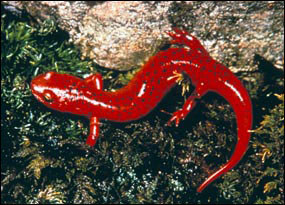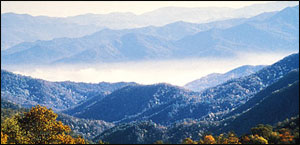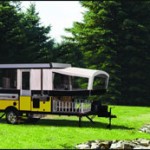The Great Smoky Mountains National Park is the most visited in the national park system, drawing 8-10 million people annually, and for good reason! The Great Smoky Mountains house a truly amazing array of wildlife and foliage. From black bears and salamanders to coyotes and woodchucks, you’ll find them here.
 General Info: The Great Smoky Mountains, a sub-range of the Appalachians, run along the border of Tennessee and North Carolina. This area has a rich history of human settlement, parts of which can still be seen today in various historic buildings.
General Info: The Great Smoky Mountains, a sub-range of the Appalachians, run along the border of Tennessee and North Carolina. This area has a rich history of human settlement, parts of which can still be seen today in various historic buildings.
Hours and Fees: The Smokies are open for visitors year round, 24-hours a day, although some roads and facilities may be closed in winter. The park does not charge an entrance fee, but there are fees for overnight camping and picnic pavilion rental.
Attractions: From hiking and horseback riding to fishing and nature walks, there’s an outdoor activity for every taste and ability. Cycling, auto touring, picnicking and historical touring are also available.
 If you’ve brought the kids or grandkids along, they’ll delight in spotting up to 43 species of amphibians in the park, which is the Salamander Capital of the World. The park’s Amphibian Checklist denotes each species by name.
If you’ve brought the kids or grandkids along, they’ll delight in spotting up to 43 species of amphibians in the park, which is the Salamander Capital of the World. The park’s Amphibian Checklist denotes each species by name.
For those who just don’t appreciate such slimy critters, there are several walking trails for wildflower viewing. The park recommends several Wildflower Walks for especially good views of springtime blooming from February to late April. In fact, the wildflowers rank Smoky Mountains #14 on the Good Sam Club’s “20 Trips Every RVer Should Take” (see Highways March 2006 for details). While you’re walking around, don’t miss the beautiful waterfalls along the trails! The Smokies are home to a dozen year-round falls thanks to the ample rainfall and changes in elevation.
 With so many choices, it may be a bit daunting to know where to start. Try downloading the Smokies Trip Planner PDF for advice on how to make the most out of your visit.
With so many choices, it may be a bit daunting to know where to start. Try downloading the Smokies Trip Planner PDF for advice on how to make the most out of your visit.
Camping Info: Big rigs should stay at Cades Cove or Smokemont, both of which accommodate RVs up to 40 feet and are open year round. Fees for either campground range from $17-$20 per night. Smaller RVs can stay at any of the six other campgrounds in the park. See the handy campground chart on the Front Country Camping Info page for specifics.
Each campground has restrooms with cold running water and flush toilets, but the park doesn’t have showers or any kind of hookups. All individual campsites have a fire grate and picnic table. Stop in at any of the neighboring communities for amenities not offered in the park (full groceries, fuel, dump station, laundry, etc.). The Cades Cove Campground Store has a snack bar offering hot and cold food and beverages, in addition to a limited stock of camping supplies and grocery items.
 Nearby Attractions: While you’re in the area, drop on by Dollywood, the family amusement park named after country music legend Dolly Parton.
Nearby Attractions: While you’re in the area, drop on by Dollywood, the family amusement park named after country music legend Dolly Parton.
The Andrew Johnson National Historic Site is 40 miles away in Greeneville, Tennessee. The site honors the life and times of the 17th President at his family home.
For a more literary experience, visit the Carl Sandburg Home just over 100 miles away in Flat Rock, North Carolina. The influential, Pulitzer Prize-winning author lived on this rural estate from 1945 until his death in 1967.
 Weather: Summers are hot and humid, so stay hydrated and dress in lightweight clothing. Weather can change drastically with the varied elevation (the peaks can be 10-20°F colder and have their own storm patterns), so bring extra layers for the summit. For weather forecasts specific to a particular season, see the park’s weather information page.
Weather: Summers are hot and humid, so stay hydrated and dress in lightweight clothing. Weather can change drastically with the varied elevation (the peaks can be 10-20°F colder and have their own storm patterns), so bring extra layers for the summit. For weather forecasts specific to a particular season, see the park’s weather information page.
Pets: You’re welcome to bring Fido along, provided your pooch is on a 6 ft. leash and you properly dispose of all excrement. The park allows dogs in campgrounds, picnic areas, along roads and on two walking trails. Learn more about pet regulations before you arrive.
If you’re from the general Smoky Mountains area or have visited the park in the past, please chime in with your stories and tips! Your insights can help others have a fantastic trip.






